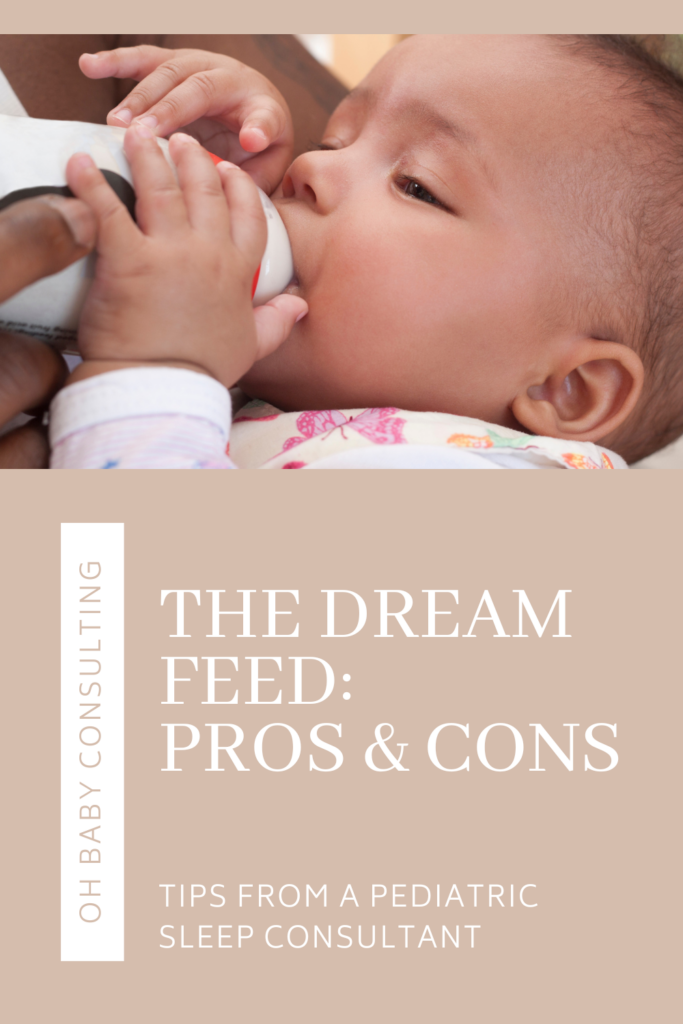A popular piece of parenting advice when it comes to overnight sleep struggles is the dream feed.
What is a dream feed?
A dream feed is when you offer your child a feeding before you go to bed (usually between 9pm-11pm) in hopes that they sleep a longer stretch. The goal is to keep your baby asleep while filling their belly and then seamlessly return them to their crib or bassinet in an attempt to avoid a midnight or early morning feeding.
The appeal here is that you can get a few extra hours of sleep after you get in bed before you have to get up and feed again. Sounds pretty dreamy, right? But much of the time, it’s just the idea of the dream feed that is so attractive, not the actual results. Plus, it can set a pretty tricky precedent that actually can create more problems down the line.
Why I’m not a fan of the dream feed
In my experience, a dream feed rarely works and if it does, the “dream” doesn’t last for long. Occasionally some parents will say that an 11:00 p.m. dream feed resulted in their baby sleeping through until 6:00 or 7:00 a.m., but more often than not, a dream feed is not as magical as it sounds. Here’s why I don’t recommend dream feeds:
It interrupts sleep: The first part of the night is when we get our more restorative period of sleep. Even though a dream feed is meant to keep baby “asleep”, in order for your child to have the tone to suck & swallow, they have to be mostly awake. Therefore, this feed actually interrupts this period of deep, restorative sleep.
It ignores a stomach/brain connection: Food is a tool for calories and is intended for nourishment. If we’re offering it during partial consciousness, it’s like eating our dinner while completely distracted – we oftentimes don’t realize how it all got eaten! When babies signal their hunger and are aware that they’re eating, they are left feeling satisfied. This connection is missing with the dream feed.
It may not actually buy you more time: For many families, the dream feed doesn’t actually make much of a difference in terms of the stretch their child gets following the feed. Many families will tell me that their child will still continue to wake up a couple hours later looking for help back to sleep.
It can create a habitual wake up: Waking your baby from a deep sleep to feed may actually disrupt their sleep/wake rhythm and interfere with their natural 24-hour cycle. This can result in the creation of a new habit where your baby starts waking up around this same time each night, even when their tummies don’t actually need a feed.
It can be counterproductive to achieving consolidated sleep: Additionally, dream feeds may actually be counterintuitive to the goal you’re trying to accomplish: helping your baby sleep through the night. A dream feed can actually perpetuate the feed-to-sleep association which is very hard to break. If your child relies on a feeding to get drowsy and fall asleep – whether this is at bedtime or during a dream feed – they are more likely to look for a feeding at other points in time during the night to help them get back to sleep between sleep cycles. Once your child is a little older, this can result in more frequent night wake-ups rather than a long, consolidated period of sleep. Usually by 12 weeks of age, a baby’s biology and development are already falling in line with consolidated nighttime sleep, but you are going to want to do everything you can to encourage that.
How to stop the dream feed?
There really isn’t any tricks to stopping the dream feed. You just…stop offering it! Depending on your child’s age and weight, they may still wake for developmentally appropriate nighttime feedings, and that’s okay! In fact, when I work with families 1:1, we sometimes maintain night feed(s) when necessary/desired. But the key differences are that baby is waking naturally and is able to sleep soundly on either side. And as a bonus – they have the tools & skills to drop off that feed when it’s no longer needed. Win-win all around!
If you are currently doing a dream feed and it is working, great! No need to mess with success. However, if there comes a time where it is no longer working – maybe your child is struggling to fall back to sleep after the feed or they are waking more frequently through the night rendering the dream feed irrelevant – you’ll know it’s time to ditch it!
I know making change feels scary, especially when you’ve been doing things a certain way for so long! So if you’re looking for other strategies to successfully extend your child’s overnight stretches, I’d love to help everyone get more sleep in a way that lasts forever!














